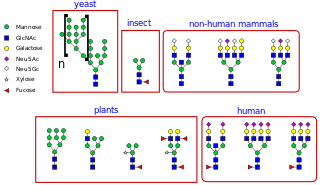 | |
| Names | |
|---|---|
| IUPAC name [(6E,10E,14E,18E,22E,26E,30E,34E,38E,42E,46E,50E,54E,58E,62E,66E,70E,74E)- 3,7,11,15,19,23,27,31,35,39,43,47,51,55,59,63,67,71,75,79-icosamethyloctaconta-6,10,14,18,22,26,30,34,38,42,46,50,54,58,62,66,70,74,78-nonadecaenyl] [(2S,3S,4S,5S,6R)-3,4,5-trihydroxy-6-(hydroxymethyl)tetrahydropyran-2-yl] hydrogen phosphate | |
| Identifiers | |
3D model (JSmol) | |
| ChemSpider | |
PubChem CID | |
| |
| |
| Properties | |
| C106H175O9P | |
| Molar mass | 1624.531 g·mol−1 |
Except where otherwise noted, data are given for materials in their standard state (at 25 °C [77 °F], 100 kPa). | |
Dolichol monophosphate mannose is a chemical compound involved in glycosylation. [1]










